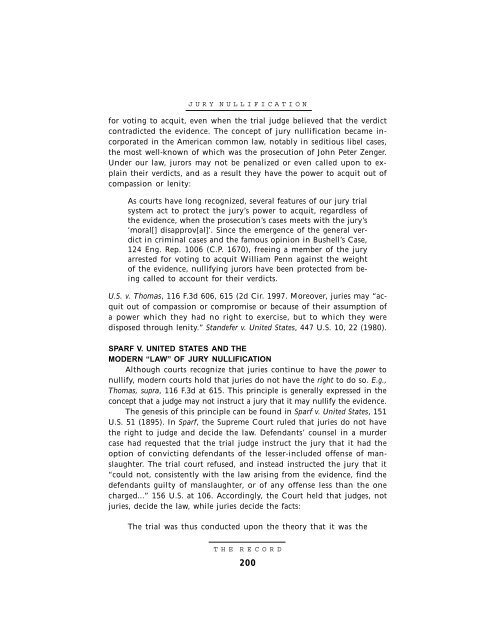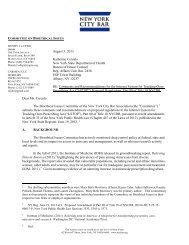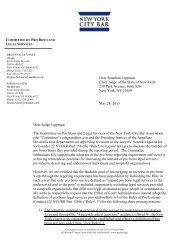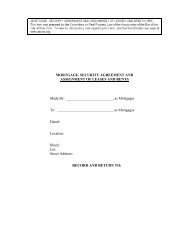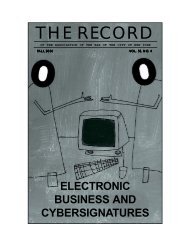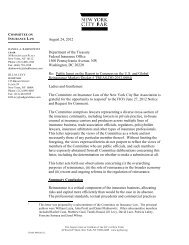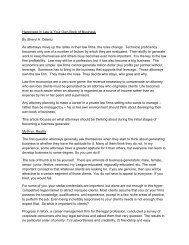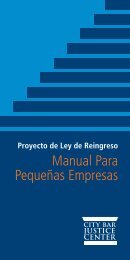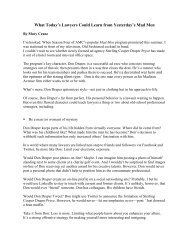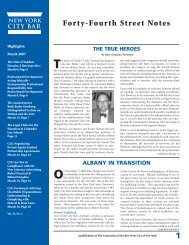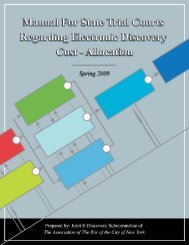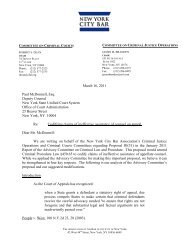THE RECORD - New York City Bar Association
THE RECORD - New York City Bar Association
THE RECORD - New York City Bar Association
Create successful ePaper yourself
Turn your PDF publications into a flip-book with our unique Google optimized e-Paper software.
J U R Y N U L L I F I C A T I O N<br />
for voting to acquit, even when the trial judge believed that the verdict<br />
contradicted the evidence. The concept of jury nullification became incorporated<br />
in the American common law, notably in seditious libel cases,<br />
the most well-known of which was the prosecution of John Peter Zenger.<br />
Under our law, jurors may not be penalized or even called upon to explain<br />
their verdicts, and as a result they have the power to acquit out of<br />
compassion or lenity:<br />
As courts have long recognized, several features of our jury trial<br />
system act to protect the jury’s power to acquit, regardless of<br />
the evidence, when the prosecution’s cases meets with the jury’s<br />
‘moral[] disapprov[al]’. Since the emergence of the general verdict<br />
in criminal cases and the famous opinion in Bushell’s Case,<br />
124 Eng. Rep. 1006 (C.P. 1670), freeing a member of the jury<br />
arrested for voting to acquit William Penn against the weight<br />
of the evidence, nullifying jurors have been protected from being<br />
called to account for their verdicts.<br />
U.S. v. Thomas, 116 F.3d 606, 615 (2d Cir. 1997. Moreover, juries may “acquit<br />
out of compassion or compromise or because of their assumption of<br />
a power which they had no right to exercise, but to which they were<br />
disposed through lenity.” Standefer v. United States, 447 U.S. 10, 22 (1980).<br />
SPARF V. UNITED STATES AND <strong>THE</strong><br />
MODERN “LAW” OF JURY NULLIFICATION<br />
Although courts recognize that juries continue to have the power to<br />
nullify, modern courts hold that juries do not have the right to do so. E.g.,<br />
Thomas, supra, 116 F.3d at 615. This principle is generally expressed in the<br />
concept that a judge may not instruct a jury that it may nullify the evidence.<br />
The genesis of this principle can be found in Sparf v. United States, 151<br />
U.S. 51 (1895). In Sparf, the Supreme Court ruled that juries do not have<br />
the right to judge and decide the law. Defendants’ counsel in a murder<br />
case had requested that the trial judge instruct the jury that it had the<br />
option of convicting defendants of the lesser-included offense of manslaughter.<br />
The trial court refused, and instead instructed the jury that it<br />
“could not, consistently with the law arising from the evidence, find the<br />
defendants guilty of manslaughter, or of any offense less than the one<br />
charged...” 156 U.S. at 106. Accordingly, the Court held that judges, not<br />
juries, decide the law, while juries decide the facts:<br />
The trial was thus conducted upon the theory that it was the<br />
T H E R E C O R D<br />
200


